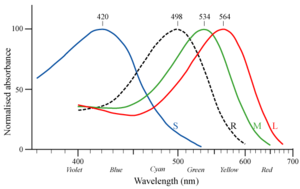Rayleigh scattering
From Wikipedia, the free encyclopedia
Rayleigh scattering (named after Lord Rayleigh) is the scattering of light, or other electromagnetic radiation, by particles much smaller than the wavelength of the light. It occurs when light travels in transparent solids and liquids, but is most prominently seen in gases. Rayleigh scattering of sunlight in clear atmosphere is the main reason why the sky is blue. Rayleigh scattering, as well as scattering by clouds both contribute to diffuse light (direct light being sunrays).
For scattering by particles similar to or larger than a wavelength, see Mie theory or Discrete dipole approximation (they apply to Rayleigh regime as well).
Contents[hide] |
[edit] Small size parameter approximation
Size of a scattering particle is defined by the ratio of its characteristic dimension and wavelength
 .
.
Rayleigh scattering can be defined as scattering in small size parameter regime x < < 1. The amount of Rayleigh scattering that occurs to a beam of light is dependent upon the size of the particles and the wavelength of the light; in particular, the scattering coefficient, and hence the intensity of the scattered light, varies for small size parameter inversely with the fourth power of the wavelength. Scattering from larger spherical particles is explained by the Mie theory for arbitrary size parameter x including small size parameter - in this case Mie theory reduces to Rayleigh approximation.
The intensity I of light scattered by a single small particle from a beam of unpolarized light of wavelength λ and intensity I0 is given by:
where R is the distance to the particle, θ is the scattering angle, n is the refractive index of the particle, and d is the diameter of the particle.
The angular distribution of Rayleigh scattering, governed by the (1+cos2 θ) term, is symmetric in the plane normal to the incident direction of the light, and so the forward scatter equals the backwards scatter. Integrating over the sphere surrounding the particle gives the Rayleigh scattering cross section σs:
The Rayleigh scattering coefficient for a group of scattering particles is the number of particles per unit volume N times the cross-section. As with all wave effects, in incoherent scattering the scattered powers add arithmetically, while in coherent scattering, such as if the particles are very near each-other, the fields add arithmetically and the sum must be squared to obtain the total scattered power.
The strong wavelength dependence of the scattering (~λ-4) means that blue light is scattered much more than red light. In the atmosphere, this results in blue wavelength being scattered to a greater extent than longer wavelengths, and so one sees blue light coming from all regions of the sky. Direct radiation (from definition) is coming directly from the Sun. Rayleigh scattering is a good approximation to the manner in which light scattering occurs within various media for which scattering particles have small size parameter.
[edit] Why is the sky blue?
During sunrise and sunset
the Sun's light must pass through a much greater thickness of the
atmosphere to reach an observer on the ground. This extra distance
causes multiple scatterings of blue light, but relatively little
scattering of red light; this is seen as a pronounced red-hued sky in
the direction towards the sun.
Because of the strong wavelength dependence (inverse fourth power) in Rayleigh regime light scattering according, one would expect that the sky would appear more violet than blue, the former having a shorter wavelength than the latter. There is a simple physiological explanation for this apparent conundrum. It turns out that the human eye's high resolution color-detection system is made of proteins and chromophores (which together make up photoreceptor cells or "Cone" structures in the eye's fovea) that are sensitive to different wavelengths in the visible spectrum (400 nm–700 nm). In fact, there are three major protein-chromophore sensors that have peak sensitivities to yellowish-green (564 nm), bluish-green (534 nm), and blue-violet (420 nm) light. The brain uses the different responses of these chromophores to interpret the spectrum of the light that reaches the retina.
When one experimentally plots the sensitivity curves for the L, M, and S color sensors, three "bell-curve" distributions with peaks at each of these wavelengths are seen to overlap one another and cover the visible spectrum. We depend on this overlap for color sensing to detect the entire spectrum of visible light. However, when one looks at the bell-curve sensitivity of the short wavelength (S) color sensor, there is a narrow detection band with a rapid fall-off in sensitivity around 450 nm. This means that our eyes are many times less sensitive to violet light (400 nm) than to blue light. As a result, although the scattered light contains more violet photons than blue ones, the physiological makeup of the eye gives a more pronounced contribution to the blue-ness of the sky.
- See also: Why is the sun yellow?
[edit] See also
[edit] References
- C.F. Bohren, D. Huffman, Absorption and scattering of light by small particles,John Wiley, New York 1983. Contains good description of asymptotic behavior of Mie theory for small size parameter (Rayleigh approximation).
- Ditchburn, R.W. (1963). Light, 2nd ed., London: Blackie & Sons, pp582–585.





